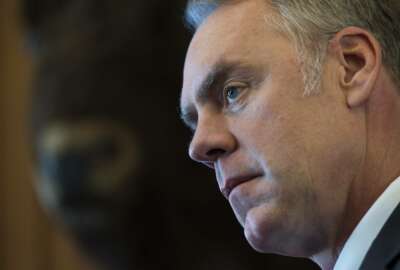
Interior didn’t document its plans or reasoning for senior executive reassignments, IG says
The Interior Department didn't document a plan, cost estimate or reasoning to offer reassignments to 35 members of the Senior Executive Service, the agency's...
Senior executives at the Interior Department have said they had little understanding of why they were reassigned to new positions within the agency with little to no notice last summer.
And after months of reviewing the reassignments, the agency’s inspector general has little idea why the agency’s leadership made the decision, either.
Interior didn’t document its plans to offer reassignments to 35 career senior executives last summer, nor did it document its reasons for reassigning the impacted individuals, according to a new report from Deputy Inspector General Mary Kendall. And because Interior’s Executive Resources Board (ERB), a body that reviews qualifications for new career applications to the SES, didn’t keep track of those decisions, the agency’s inspector general said it can’t determine if the reassignments comply with federal statute.
The inspector general conducted this report, which was highly anticipated, at the request of eight members of the Senate Energy and Natural Resources Committee.
Lack of documentation meant that the IG relied on interviews with Interior’s ERB members and the impacted executives.
“We asked each ERB member what, or who, prompted the reassignments and how they identified the senior executives for reassignment,” Deputy Inspector General Mary Kendall wrote. “Despite repeated attempts to understand the direction or guidance given by departmental leadership, we only received broad explanations of reassigning senior executives.”
The time an SES member spent in a current position, moving the executive out of the Washington, D.C. area and moving the executive to other functional areas in the agency, were among those broad reasons. But the IG said it found no evidence that Interior evaluated the reassignments against those reasons.
“When we asked the ERB members who in the Department leadership ordered the reassignment of senior executives, no one could provide an answer,” Kendall wrote. “One ERB member told us that the ERB members only discussed senior executives who they knew or had experience with and that there was not much thought or discussion given to reassigning senior executives they did not know.”
The Interior Department proposed reassignments to 35 of 227 senior executives between June 15 and Oct. 29, 2017, according to the IG. A total of 27 executives made the transfer. Of the remaining eight, three resigned before the positions began, three had their reassignments rescinded and two stayed in their current positions before retiring.
As the senior executives have previously described, the decision was quick. Interior Secretary Ryan Zinke formed the agency’s Executive Resources Board on May 19. At the ERB’s first meeting on June 2, members discussed the possibility of reassignments. The board on June 15 briefed the agency’s assistant secretaries, bureau and office directors on the reassignments and then notified most of the impacted executives by email later that day.
The found no documented evidence that the ERB reviewed executives’ qualifications before issuing reassignment notices, the IG said. Board members said they reviewed short biographies of Interior SES members, but they didn’t discuss the executives’ qualifications with their supervisors and didn’t consult with the executives.
In addition, the ERB didn’t consider the costs of moving some executives to a new geographic location, the IG said. Some reassigned executives didn’t receive a position description for their job until more than two weeks later, Kendall added.
The agency never communicated its intention to reassign executives before it released transfer notices, the IG said. Interior has reassigned its executives before — 168 of them between 2009 and 2017 — according to the inspector general. But many of the impacted executives said they were engaged with the process during previous reassignments.
The IG interviewed 31 of the 35 affected executives. Of the 27 executives Interior successfully reassigned, eight told the IG they held a positive perception of the transfer. But 10 executives said they believe they were reassigned for political or punitive reasons, while eight cited a conflict with Interior leadership as a possible reason.
“When interviewed, 17 senior executives selected for reassignment questioned whether these reassignments were political or punitive, based on a prior conflict with DOI leadership or on the senior executive’s nearness to retirement,” Kendall wrote. “Many executives speculated that multiple reasons applied. Twelve of the senior executives believed their reassignment may have been related to their prior work assignments, including climate change, energy or conservation.”
Though 12 executives said they believed they were reassigned due to their prior work, seven told the IG they thought their reassignment was age or retirement related.
As Federal News Radio previously reported, reassigned senior executives said the move left them feeling demoralized and undervalued.
Agencies, by law and under certain requirements, can reassign their senior executives to new positions, and SES members have largely recognized their departments have the discretion to make these moves.
But an agency’s Executive Resources Board typically weighs in on these reassignments and documents the process along the way. The IG found several problems with Interior’s ERB, which didn’t have an official charter, didn’t document its activities and lacked a balance of career and political members.
All six of the members on Interior’s ERB at the time the reassignment decision was made were political appointees, the IG said. Typically, a mix of political and career employees should sit on the executive board, per OPM recommendations.
“This is just a cautionary tale of what happens when you don’t have sufficient governance mechanisms in place to prevent what could appear to be undue political influence on the SES,” said SEA President Bill Valdez.
SEA has raised questions with the structure of agency ERBs before to OPM back in 2010. SEA said the Office of Personnel Management should consider more specific regulations governing agency ERBs, but the organization said nothing came of its proposals.
The IG offered four recommendations for Interior. The department should have a documented plan for making future SES reassignments, should communicate with executives before issuing final notifications and estimate future reassignment costs, the IG said. In addition, the inspector general recommended Interior follow OPM guidance for establishing an ERB.
In response to the IG’s recommendations, Deputy Interior Secretary David Bernhardt said he’s asked Secretary Ryan Zinke to begin restructuring the ERB to include a mix of political and career professionals. The ERB is also drafting an official charter.
“The department’s after-the-fact improvements to its management of its Executive Resources Board, while welcome, are inadequate,” Valdez said in a statement. “SEA will aggressively pursue legislative and regulatory remedies to ensure that such abuses of dedicated career civil servants will not occur again — at the Department of Interior or any other federal agency.”
Bernhardt in December told SES members he continues to view reassignments as a “valuable management tool.”
Copyright © 2025 Federal News Network. All rights reserved. This website is not intended for users located within the European Economic Area.
Nicole Ogrysko is a reporter for Federal News Network focusing on the federal workforce and federal pay and benefits.
Follow @nogryskoWFED






